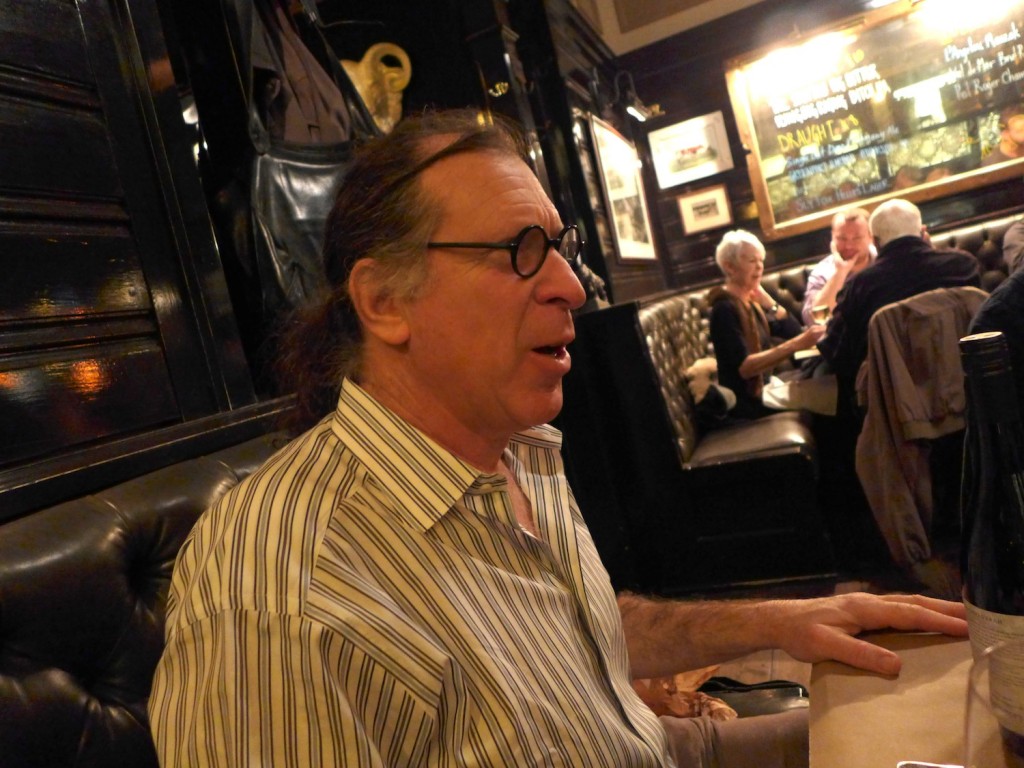Good writers steal all their best ideas, but then they give them a twist the person they took them from would never have thought of. In this kind of way I got the idea for ROCK STARS OF WINE AMERICA from Randall Grahm (pictured above on the big day), the charmingly crazy and sensationally creative winemaker of Bonny Doon Vineyards of Santa Cruz in California, who I first met at the winery on March 2nd, 1992. That day he told me that California should, “make wines that celebrate our image.” When I asked him what his home state’s advantages for winemaking he told me, “1) lack of history, 2) flexibility, 3) cheap land, 4) sunshine.” Beginning with his Rhône-style red Le Cigare Volante (first vintage 1984) he’s built one successful one new wine brand after the other, later selling some of them for stacks of millions, only to move on to the next daring high risk project.
At lunchtime on November 18th 2013 we sit next to one another in The Breslin Restaurant in the ACE Hotel on just off Broadway. After presenting his new wines to a small group of people from NYWC (New York Wine City) Randall became very quiet and thoughtful. Suddenly the words popped out that were to set me thinking, then traveling and writing. “Nobody’s written about the sea change in the wine industry. 20 years ago it was much more idealistic. People in the wine industry wanted meaning and now they want money. OK, I’m interested in both. Now there’s a cynicism and self-consciousness, and a sense of randomness…The weird thing is 20 years ago your job as a winemaker was to make a really great wine. If you did, then you sold it. Now you don’t know if you can sell it! Then you’ve got all the new shock labels. Is that how you sell wine now?”
Finally, he rather sheepishly acknowledged that, of course, he was responsible for some of the first eccentric wine labels. Some of them were sitting on the table in front of us! That only made what he said all the more fascinating. Was it true? And if so, did it apply only to California, or Wine America as a whole? Here was a Big Question that it would be exciting to answer, and I don’t mean a nice round answer, rather the jagged-edged truth.
Shortly after I get to know another extraordinary winemaker from California, Clark Smith (pictured above). The author of Postmodern Winemaking (2013, University of California Press) uses science to debunk the myths and misnomers that afflict the wine scene, obscuring its members’ view of the real world of wine. We met at a tasting of American wines in the cellar of the ACE Hotel on December 15th 2013. He began with some sweeping assertions. “The paparazzi of the wine industry have hit us with the accusation of manipulation.” He was talking about my profession, and I cast nervously around the room to see which of my colleagues were there, but I was the only wine journalists present, in fact NYWC was conspicuous by its absence. “It is my view that all winemaking is extremely manipulative. It’s all about artisanality,”he continued. Of course, artisanal derives from “art”, which we in the West traditionally contrast with nature. Today “natural” and “authentic” are crucial words for NYWC and the scene everywhere on Planet Wine, but when I hear them I often wonder what my colleagues are really talking about.
Then came an even more important observation. “If you count the number of different brands that each state produces, rather than the number of gallons of wine each producers, then California doesn’t dominate American wine in anything like the same way.” What he was talking about is the fact that a very large proportion of California’s wine production goes into a very small number of brands. The production figure for each of them needs to be so high in order to enable them to be nationally distributed in a nation with 310 million inhabitants. Because, for example, few wineries in New York State distribute outside the Northeast so there are few larger brands and very many different wines considering a total statewide wine production that’s a fraction of California’s. That makes for stylistic diversity, and is often married to idealism.
The blind tasting that followed his remarks demonstrated again and again the amazing diversity of American wine. What were the high points? Norton is arguably the American wine grape and the 2010 Norton from the Augusta Winery in August/Missouri (a short drive outside St. Louis) was a powerful red wine that could hold its own against the best from California, but costs under $20 from the winery! Even more exotic, but equally delicious was the red Petit Blue from Hermit Woods Wines in Meredith/New Hampshire. All the experts present praised the last wine when they tasted it blind, but none guessed it was actually made from wild blueberries and honey! Clearly some major stuff had happened in Wine America but so far gone either completely or largely unreported. It struck me then that if Randall was right with his observations, then they apply far more to California than the rest of America.
I realized that I’d already begun investigating what I now call the Other Wine America, the one that doesn’t either belong to the California mainstream, or try to imitate it, many years before. For example, there were my trips to South Dakota in 2005 and 2010, and my more recent discovery of the New Jersey’s wine industry. During much of 2014 I was very busy promoting my book BEST WHITE WINE ON EARTH – The Riesling Story (Stewart, Tabori & Chang), but all the time the Other Wine America was getting its claws deeper and deeper into me. I had to throw myself into this and a trip to see the wine industry of Arizona in November 2014 convinced me that I indeed had a Big Subject that few of my colleagues were taking seriously. It was an intoxicating thought.
At the end of last year I realized that I had a great opening story for a book about America, Wine and I in the outrageous tale of my first visit to the USA in September 1985. This had the advantage of never having been told in writing before, and I immediately knew that if I was going to use it I had to describe those events as if they had happened yesterday. However, there would then be a big jump from this story to the following ones that would focus on the present. Could I risk that? I felt very hesitant for a while.
It was my American therapist in Berlin, Dr. Brian Pheasant (sorry no photo) who gave me the decisive push that made me start work on what is now ROCK STARS OF WINE AMERICA #1. He loved the thought of me writing something outrageous, no doubt because he felt this would be therapeutic for me. And mostly his advice had proved to be spot on, at least when I followed it thoroughly. Suddenly all the ideas came together in my head and all I needed to do was write. That’s now the task facing me with issue #2. The subject is Arizona. WATCH THIS SPACE!
In the meantime you can click the link below and buy #1!



![120114_riesling_global_RZ [1600x1200]](http://www.stuartpigott.de/wp-content/uploads/2015/10/120114_riesling_global_RZ-1600x1200.jpg)
My comments to Stuart at the Breslin on Nov. 18th, 2013 continue to hold true. I had said that day that at one point in history, people got into the sundry aspects of the wine business – as a winemaker, winery owner, grape grower, wholesaler, retailer or wine writer – out of a sheer love of the product, just savoring the opportunity to have wine in one’s life every day. There was little expectation that one’s activity would ever truly be greatly remunerative. But somewhere along the line, some people in the wine business realized that one could make money – indeed, lots of it – marketing the wine “life-style.” Not only could one make money, but one could also enjoy what was perceived as a glamorous life-style.* This was the fateful poisoned fruit. Where we are now: Everyone, the world over, has simultaneously decided that they need to become a winemaker or winery owner, and the level of competition to successfully sell one’s bottle of wine is absolutely unprecedented. Small wineries are pitted against large corporate entities with vast budgets to inundate social media with mention of their essentially non-memorable, unnecessary, commodity product. But what is most significant is that the wine business is now not so much about wine, but rather about the language that surrounds it. It has become a power struggle to control the narrative. Put another way, one can no longer simply make really good or even excellent wine, sold at a fair price, and have any expectation of selling this wine, unless one is able to somehow force an association with a powerful and compelling set of memes. Therefore, it’s not enough to simply make an elegant, delicious pinot noir, one must somehow heroically set out “in pursuit of balance.” One can’t simply make a really complex, ageworthy, red wine. One must establish its credentials as it were, by demonstrating that it partakes of a certain set of favorable associations, whatever those might be: Estate grown, dry-farmed, low-yielding, “mineral-intensive,” Biodynamically farmed, old-vines, a sexy appellation. Kermit Lynch might himself drink wine and personally enjoy it, but his customers lap up his words as avidly as they sip his juice.
*The actual life of a winemaker, who actually spends more time out in the “market,” flogging his product in an endless stream of winemaker dinners, sales meetings with wholesalers, and in-store public tastings, exhorting reluctant customers to sample his wares from 2 oz. plastic cups under the glare of harsh florescent lighting, rather than in blissful communion with Mother Nature, contemplating le moment juste to harvest his precious crop, is significantly less glamorous than it is generally perceived.
Randall,
Many, many thanks for your comments. This is all very important stuff that isn’t talked about nearly enough. The struggle to control the narrative about wine also strikes me as the major new aspect of the process, although already 15 years ago I heard winemakers with massive, gooey Cult Cabs talking about their wines as being “transparent” and “mineral”. Since then the Wine Narrative War has truly broken out, but this is all too seldom observed, let alone critically examined. Of course, much of the “natural” wine scene is wallowing in this like a hippopotamus bathing in mud, yet it seems to be regarded as a crime against Humanity and Nature to even observe this simple fact. Soon they will be publicly burning heretics like us like they used to do with witches, and the flames will be fed with those little plastic cups!